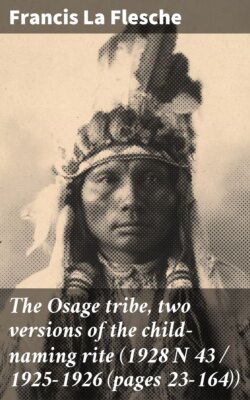Читать книгу The Osage tribe, two versions of the child-naming rite (1928 N 43 / 1925-1926 (pages 23-164)) - Francis la Flesche - Страница 41
На сайте Литреса книга снята с продажи.
Wi´-gi-e of the Bow People
ОглавлениеTable of Contents
The E-noⁿ´ Miⁿ-dse-ṭoⁿ, a people who belong to the same great tribal division as the Wa´-ṭse-ṭsi, use a similar wi´-gi-e, which is as follows:
I am a person who is fitted for use as a symbol.
Verily, in the midst of the rushing waters
Abides my being.
Verily, I am a person who has made of the waters his body.
Behold the right side of the river,
Of which I have made the right side of my body.
When the little ones make of me their bodies
And use the right side of the river
To make their bodies,
The right side of their bodies shall be free from all causes of death.
Behold the left side of the river,
Of which I have made the left side of my body.
When the little ones also make of it the left side of their bodies,
The left side of their bodies shall always be free from all causes of death.
Behold the channel of the river,
Of which I have made the hollow of my body.
When the little ones make of me their bodies,
The hollow of their bodies shall always be free from all causes of death.
A bowl of shelled corn, the life symbol of the Tho´-xe gens, was also placed before the head of the Ṭsi´-zhu Wa-shta-ge gens. (For the Maize Wi´-gi-e of the Tho´-xe gens, see 36th Ann. Rept. Bur. Amer. Ethn., p. 135, lines 57 to 113; also p. 277, lines 83 to 110.)
When the bowls of water and cedar fronds and shelled corn are placed before the Ṭsi´-zhu Wa-shta-ge, the Sho´-ḳa puts in his arms the child to be blessed and named. The head of the Ṭsi´-zhu Wa-shta-ge gens then passes the tips of the fingers of his right hand over the bowl of water and cedar fronds, and the bowl of the life-giving corn, then touches with the tips of his fingers the lips, head, arms and body of the child. The two bowls and the child are then passed on to the head of the Wa´-ṭse-ṭsi Wa-shta-ge gens, who goes through the same motions with the child. The child and the two bowls are then passed on to the heads of each of the other gentes who make the same motions over the child as were made by the heads of the first two gentes.
These ceremonial acts performed by the heads of the gentes officiating, by which the child is brought into touch with the ever-flowing waters, the red cedar, an everlasting tree, and the life-giving corn, are supplicatory acts by which the aid of Wa-ḳoⁿ´-da is sought for the child who is to go forth to take part in the great life activities. Not only is the attainment of old age desired for the child but also the continuity of its life by a never-ending line of descendants.
At the close of these ceremonial acts a sacred gentile name is conferred upon the child without further ceremony. If, however, there are two or more names to choose from, as is the case in some of the gentes, the mother of the child has the privilege of making a choice from two or three names. This privilege is given by the Xo´-ḳa, who offers to the mother two small sticks prepared for this purpose, each of which represents a name mentioned in the origin ritual of the gens naming the child. The mother usually chooses the stick representing the name which to her has the greater religious significance and is the most euphonious.
